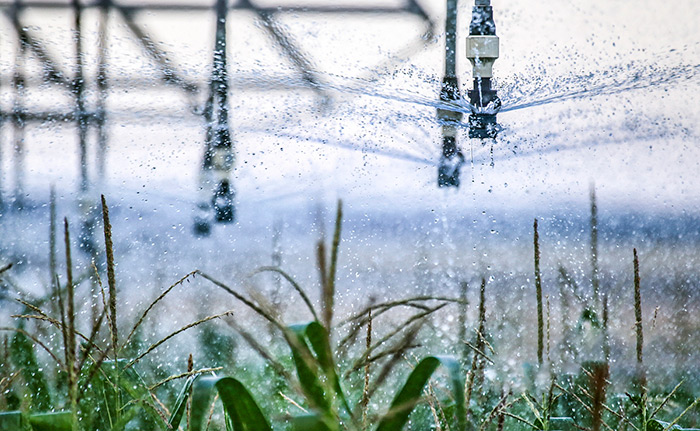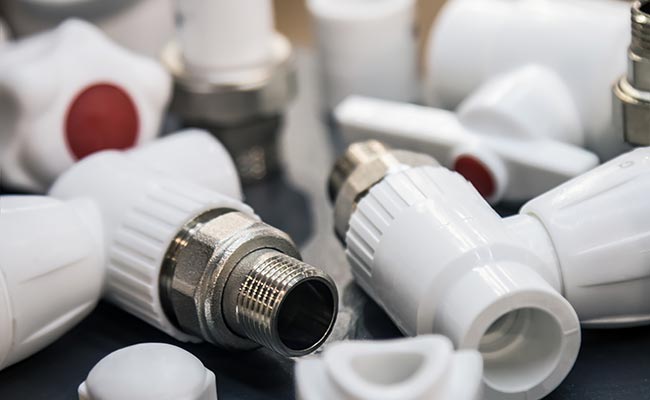Confused by different valve types? Choosing the wrong one can mean you have to cut a perfectly good valve out of a pipeline just to fix a tiny, worn-out seal.
A two-piece ball valve is a common valve design made from two main body sections that screw together. This construction traps the ball and seals inside, but allows the valve to be disassembled for repair by unscrewing the body.
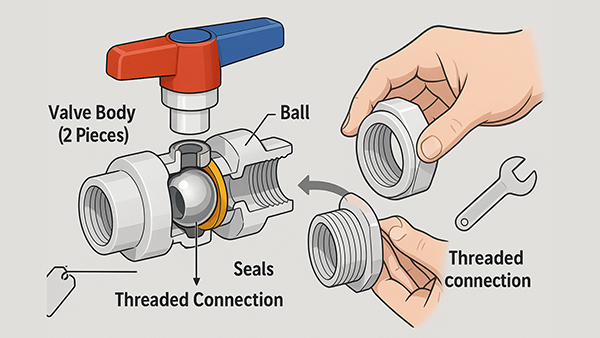
This exact topic came up in a conversation with Budi, a purchasing manager I work with in Indonesia. He had a customer who was frustrated because a valve in a critical irrigation line started to leak. The valve was a cheap, one-piece model. Even though the problem was just a small internal seal, they had no choice but to shut everything down, cut the entire valve out of the pipe, and glue a new one in. It turned a five-dollar part failure into a half-day-long repair job. That experience immediately showed him the real-world value of a repairable valve, which led us straight to a discussion about the two-piece design.
What is the difference between 1 piece and 2 piece ball valves?
You see two valves that look similar, but one costs less. Choosing the cheaper one might seem smart, but it could cost you much more in labor if it ever fails.
A 1-piece ball valve has a single, solid body and is disposable; it cannot be opened for repair. A 2-piece valve has a threaded body that allows it to be taken apart, so you can replace internal parts like seats and seals.

The fundamental difference is serviceability. A 1-piece valve is made from a single piece of cast material. The ball and seats are loaded in through one of the ends before the pipe connection is formed. This makes it very inexpensive and strong, with no body seals to leak. But once it’s built, it’s sealed forever. If an internal seat wears out from grit or use, the entire valve is trash. A 2-piece valve costs slightly more because it has more manufacturing steps. The body is made in two sections that screw together. This allows us to assemble it with the ball and seats inside. More importantly, it allows you to disassemble it later. For any application where a failure would cause a major headache, the ability to repair a 2-piece valve makes it the superior long-term choice.
1-Piece vs. 2-Piece At-a-Glance
| Feature | 1-Piece Ball Valve | 2-Piece Ball Valve |
|---|---|---|
| Construction | Single solid body | Two body sections threaded together |
| Repairability | Not repairable (disposable) | Repairable (can be disassembled) |
| Initial Cost | Lowest | Low to Medium |
| Leak Paths | One less potential leak path (no body seal) | One main body seal |
| Typical Use | Low-cost, non-critical applications | General purpose, industrial, irrigation |
What is a two-piece valve?
You hear the term “two-piece valve” but what does that mean practically? Not understanding this basic design choice can lead you to buy a valve that isn’t right for your needs.
A two-piece valve is simply a valve whose body is constructed from two main parts that are joined together, usually with a threaded connection. This design provides a great balance between manufacturing cost and the ability to service the valve’s internal parts.
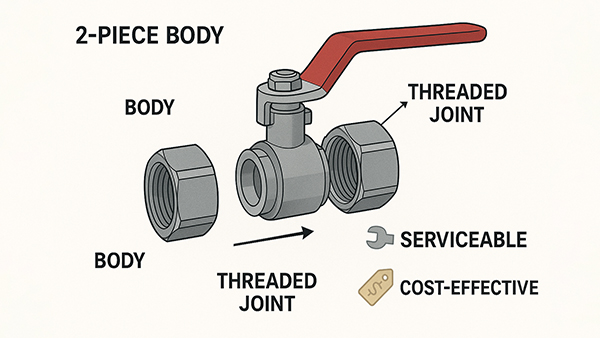
Think of it as the industry standard for a repairable, general-purpose ball valve. The design is a compromise. It introduces a potential leak path at the point where the two pieces of the body screw together, something a 1-piece valve avoids. However, this joint is protected by a robust body seal and is very reliable. The huge benefit this creates is access. By unscrewing this joint, you can get directly to the valve’s “guts”—the ball and the two circular seats it seals against. After Budi’s customer had that frustrating experience, he decided to stock our 2-piece valves. He tells his clients that for a small extra upfront cost, they are buying an insurance policy. If a seat ever fails, they can buy a simple repair kit for a few dollars and fix the valve, rather than paying a plumber to replace the whole thing.
What is a two ball valve?
Have you ever heard the term “two ball valve”? Using incorrect names can lead to confusion and ordering the wrong parts, causing project delays and wasting money.
“Two ball valve” is not a standard industry term and is usually a mispronunciation of “two-piece ball valve.” In very specific-use cases, it could also mean a double ball valve, which is a specialized valve with two balls inside a single body for high-security shutoff.
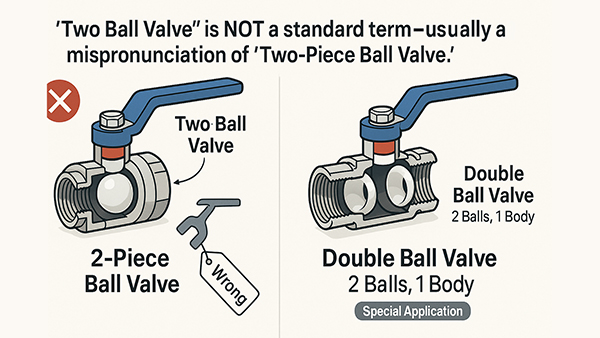
This confusion comes up sometimes, and it’s important to clarify. Ninety-nine percent of the time, when someone asks for a “two ball valve,” they are talking about a two-piece ball valve, referring to the body construction we’ve been discussing. However, there is a much less common product called a double ball valve. This is a single, large valve body that contains two separate ball-and-seat assemblies inside it. This design is used for critical applications (often in the oil and gas industry) where you need a “double block and bleed.” This means you can close both valves and then open a small drain between them to safely verify a complete, 100% leak-proof shutoff. For typical PVC applications like plumbing and irrigation, you will almost never encounter a double ball valve. The term you need to know is “two-piece.”
Clearing Up the Terminology
| Term | What It Actually Means | Number of Balls | Common Use |
|---|---|---|---|
| Two-Piece Ball Valve | A valve with a two-part body construction. | One | General purpose water and chemical flow. |
| Double Ball Valve | A single valve with two internal ball mechanisms. | Two | High-security shutoff (e.g., “double block and bleed”). |
What are the three types of ball valves?
You have learned about 1-piece and 2-piece valves. But what if you need to do repairs without shutting down the whole system for hours? There’s a third type for exactly that.
The three main types of ball valves, categorized by body construction, are the 1-piece, 2-piece, and 3-piece. They represent a scale from lowest cost and no repairability (1-piece) to highest cost and easiest serviceability (3-piece).
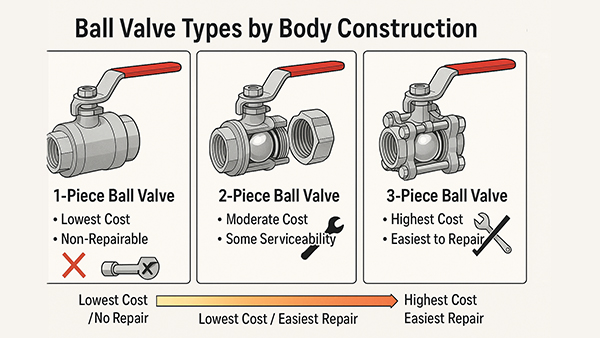
We’ve covered the first two, so let’s complete the picture with the third type. A 3-piece ball valve is the premium, most easily serviced design. It consists of a central body section (which holds the ball and seats) and two separate end caps that are connected to the pipe. These three sections are held together by long bolts. The magic of this design is that you can leave the end caps attached to the pipe and simply unbolt the main body. The center section then “swings out,” giving you complete access for repairs without ever having to cut the pipe. This is invaluable in factories or commercial settings where system downtime is extremely expensive. It allows for the fastest possible maintenance. Budi now offers all three types to his customers, guiding them to the right choice based on their budget and how critical their application is.
Comparison of 1, 2, and 3-Piece Ball Valves
| Feature | 1-Piece Valve | 2-Piece Valve | 3-Piece Valve |
|---|---|---|---|
| Repairability | None (Disposable) | Repairable (Must remove from line) | Excellent (Repairable in-line) |
| Cost | Low | Medium | High |
| Best For | Low-cost, non-critical needs | General purpose, good balance of cost/features | Critical process lines, frequent maintenance |
Conclusion
A two-piece ball valve offers repairability by having a body that unscrews. It’s a fantastic middle ground between the disposable 1-piece and the fully in-line serviceable 3-piece valve models.
Post time: Jul-10-2025


